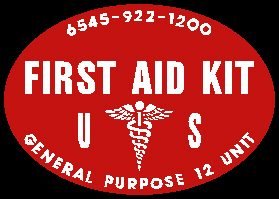First Aid

Xavier,
Being a nurse and all, what do you think should be included in a first aid kit? I would like to put one together for my wife and myself, to carry in our car. We are both average folks with a basic working knowledge of First Aid. I just believe in being over prepared and hoping we'll never need this stuff. Also, given our situation, it might be preferable to buy a kit rather than put one together ourselves.
Mark
Mark,
The most important thing is not in any kit. That thing is knowledge and the willingness to use it.
My own kit consists on various gauze sponges, 4 inch silk tape, a couple of oral airways, some cord, a 12 inch piece of broomstick, a CPR mask, a pamper, a pair of "cut anything" scissors, a couple of opsites, a bottle of NTG, and an analphylactic kit containing epi, benadryl, and decadron as well as a couple of syringes. My "kit" is kept in a ammo box in the back of the car.
If you can only chose one thing though, choose knowledge, and supplement that with a creative mind that can improvise under pressure.
Best regards,
XB
Labels: Nursing








5 Comments:
This might be stupid but what is NTG?
nitroglycerine
And, those among us not closely associated with the medical field can get an analphylactic kit...how? I suppose I could get my MD to write a scrip for it.
Doesn't heat affect the epi? How often do you replace it?
I'm told, but have no proof, that poppers works pretty well as a nitro glycerine substitute. (both volatile nitrate esters giving off nitric oxide).
Anyone with angina out there ever tried it?
Alternativly, does the headache from nitroglycerine kill the passion rather than "organise the room"
Never did work out what the old timers used "sweet spirits of nitre" for... ...apart from a dubious addition to rust bluing potions.
A good general rule for any kit is that it should provide you with the tools you need to do your job. Once you know what you can do, then you know what you need to carry.
For example, suppose that in a first aid situation, you know how to do A, B, and C. The contents of your kit are easy to discern - it should provide you everything you need for A, B, and C, nothing more, or less.
Do you know how to control bleeding from an external wound? Then you know what you'll need to have on hand in order to control it. Can you splint an arm, or a leg, or a collarbone? If you can, you know what you need for that, too. Can you flush debris from an eye, bandage a blister, remove a splinter? Do you even want to bother with such things? Decide what you want to prepare for, and then the equipment list writes itself.
Post a Comment
<< Home